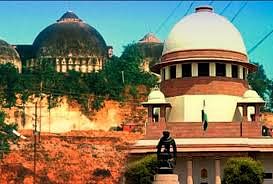
Ayodhya Verdict
- PC : MRP
The whole country was waiting for the most awaited decision on the 2.77 Acre of disputed land in Ayodhya. A Five-Judges Bench has been set by the Supreme Court of India to declare its verdict on the disputed land.
The Bench has ordered that a temple must be constructed at the disputed site.
Meanwhile keeping in the note, the sentiments of Muslims, the Bench compensated them with five acres of land at a prominent place in Ayodhya.
Keeping in mind the safety, the government of the various state has declared 3 days holiday in the whole state.
All schools, colleges and educational institutes would remain closed in Jammu, Uttar Pradesh, Karnataka, Madhya Pradesh and Rajasthan ahead of the Ayodhya Verdict from November 09 to 11, 2019.
Do you know; What is Babari Masjid Land dispute?, How the dispute began?, Which Parties are involved in it? & Other interesting facts about ‘Ram Janmabhoomi’.
Through this article you will get to know about various unknown and interesting facts about the ‘Ayodhya RamJanmabhoomi Vivad’.
First of all let's know about the disputed land for which the Supreme Court is delivering the verdict today, November 09, 2019.
Before the demolished of Babari Masjid on 6 December 1992. The disputed land of 2.77 acre consists of;
- Ram Chabutra,
- Hanuman Dwar,
- Bhandar,
- Sinh Dwar,
- Sita Rasoi.
Apart from the three domes;
- Southern Dome,
- Central Dome,
- Northern Dome.
How did the dispute begin?
In 1885, a Mahant named Raghubir Das proposed to build a temple at the Ram Chabutra. According to some media reports, the Ram Chabutra was said to be built in 1855. The place was worshipped as the Lord Ram's birthplace.
However, British India’s Faizabad District Court refused to give permission to build a temple. Later on December 22-23, 1949, Idols of Lord Ram, Sita and Laxman placed inside the Masjid under the Central Domes by a priest called Abhiram Das.
Later on, 29th December 1949, the land was declared as the disputed site by the Faizabad District Court. The land was locked up by the officials.
Parties Involved in the Dispute;
- Nirmohi Akhara
- Sunni Central Waqf Board,
- Gopal Singh Visharad,
- Deoki Nandan Agarwal,
- Akhil Bharatiya Hindu Mahasabha,
- Mahant Suresh Das,
- Akhil Bhartiya Sri Ram Janam Bhoomi Punarudhar Samiti,
- M Siddiq (General Secretary,Jamiat-ul Ulema-i Hind),
- Mohammad Hashim Ansari,
- Shia Central Board of Waqf,
- Farooq Ahmad,
- Haji Phenku,
- Haji Misbahuddeen,
- Akhil Bharatiya Hindu Mahasabha
- Vishva Hindu Parishad
- Ram Janmabhoomi Nyas
- Shiv Sena
- Bharatiya Janata Party
- Liberhan Commission
- Nirmohi Akhara
- Rashtriya Swayamsevak Sangh
Also Read: Ayodhya Verdict: Key Points You Should Know About the Case
In 1959, the Nirmohi Akhara filed a petition claiming that the land has been managed by their ancestors and worship to Lord Ram has been done by them for several centuries.
In 1961, the Sunni Central Waqf Board also staked a claim stating that the land was owned by them as it was granted to them as waqf property by the Mughals.
In 1986 the locks of the disputed site were broken on the order of Faizabad District Judge, which later turned into a national issue.
In 1992, the Ram Janmabhoomi movement results in culminating the demolition of Babri Masjid.
By the evening of December 06, 1992, the Ram Janmabhoomi movement which was accompanied by 1.5 lakh volunteers or karsevaks had demolished the Babari Masjid.
In 2010, After years of hearing the Allahabad High Court delivered its verdict and ordered to divide the 2.77 Acres of land among three parties;
- Nirmohi Akhara,
- Ram Lalla Virajman
- Sunni Central Waqf Board.
However, the parties were not happy with the Allahabad High Court Judgement and filed a petition in the Supreme Court of India.
The verdict delivered by the five-judge bench could be the final decision on the 2.77 Acre of disputed land in Ayodhya.








